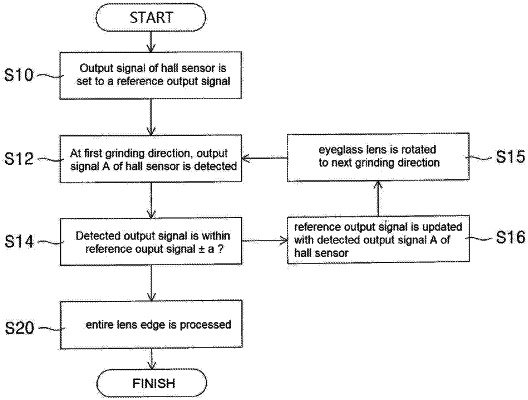| CPC B24B 9/148 (2013.01) [B24B 9/146 (2013.01); B24B 13/00 (2013.01); B24B 13/06 (2013.01); B24B 49/10 (2013.01)] | 2 Claims |

|
1. An eyeglass lens processing method, comprising the steps of:
determining a reference output signal “A0” when a carriage (12) mounted with a lens contacts with a grinding wheel mounted frame (22) mounted with a grinding wheel (20) for grinding the lens, wherein the reference output signal “A0” is determined with a hall sensor detector (30) including a magnet (32) which is equipped on either one of the carriage (12) and the grinding wheel mounted frame (22) and a hall sensor (34) which is equipped on the other one of the carriage (12) and the grinding wheel mounted frame (22) and detects an intensity of a magnetic field generated by the magnet (32);
performing a lens processing to a target depth at a first grinding direction, detecting an output signal of the hall sensor (34), and determining whether the output signal of the hall sensor (34) is within “A0±a” (a: tolerance), wherein the tolerance “a” is a range for determining whether the output signal of the hall sensor (34) is equal to the reference output signal, and the tolerance “a” is 2% of the reference output signal;
determining that the grinding wheel mounted frame (22) and the carriage (12) are in contact and finishing the lens processing at the first grinding direction when the output signal of the hall sensor (34) is within “A0±a” (a: tolerance), and updating the reference output signal to “A1” which is an output signal of the hall sensor (34) at that time; and
rotating the lens to a second grinding direction which is a next grinding direction, and repeating the determining step and the updating step of the reference output signal for processing the entire lens edge.
|